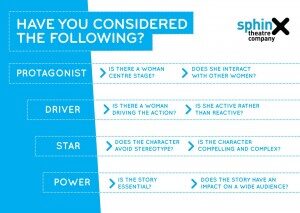
Women In Theatre: Redressing the Balance
Guest blog by Sphinx Theatre
We here at Sphinx have been at the forefront of addressing the gender imbalance in theatre since 1975. In 1983 Sphinx Artistic Director Sue Parrish fronted a report by the Conference of Women Theatre Directors and Administrators on the status of women in theatre highlighting that out of the 1024 productions surveyed only 11% were written by women, mostly accounted for by productions of Agatha Christie plays. In 2006 Sphinx surveyed 104 productions finding only 9% were written by women. Recent research from Purple Seven on over 6000 plays at 159 UK venues from 2012 – 2014 tells us that women have only taken up 39% of stage roles consistently since 2012 whilst female playwrights are currently representing 32% of produced plays surveyed in 2015, a huge jump on 2014’s 27% whilst 39% of the productions surveyed were directed by women. These improvements, dramatic when put into context with the 1983 survey, are all good news but they are still not the 50% that would signify equal representation of women onstage.
The apparent equal treatment by female critics against the potential biases of male critics highlighted in the survey is also very interesting showing that plays with casts of at least 50% women received high ratings from female reviewers whilst male-heavy casts were much more likely to receive four or five stars from men.
This supports the anecdotal evidence given by Vicky Featherstone, Artistic Director of the Royal Court that male critics are harder on women. It does not however, support the reported statement made by Featherstone that audiences feel uncomfortable with a female led narrative stating that ‘plays by men do sell more tickets, but while female-led productions are given smaller runs in smaller venues it’s difficult to say whether this is an inherent preference of audiences, or whether we simply attend what’s on offer’. It’s possible that because of UK Theatre’s tradition towards the male led repertoire women are placed at the margins and in consequence the ambition and the expected scale of work from female playwrights is confined.
Furthermore although this survey shows that 39% of the roles onstage were performed by women it does not analyse the quality of those roles or shed any definitive light on the scale of female subordinate roles. It is this subordination and marginalising that we are hoping to redress with our newly launched Sphinx Test.
In response to the Bechdel Test – the film industry’s barometer of gender equality on screen we’ve launched our own test for analysing gender balance in UK theatre.
Launched at the Sphinx Salon on 28th November, the Test will be distributed to writers, directors, commissioners, producers and venues across the industry – with the support of the Writers’ and Directors’ Guilds – as a tool for considering gender equality in new work. We hope it will enable writers and artists at all levels to consider unconscious biases and gender balance more easily and in so doing help create more and better roles for women on the UK stage.

References:
The Purple Seven survey is available at http://purpleseven.com/media.ashx/gender-thought-leadership.pdf
For more information on the Conference of Women Theatre Directors and Administrators and Sphinx Surveys please contact [email protected]
Further Company Information:
@sphinxtheatre
https://www.facebook.com/SphinxTheatreCompany/
Share on FacebookShare on Twitter
